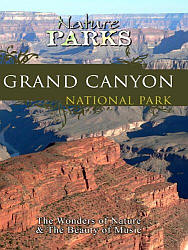Grand Canyon National ParkArizona - Travel Video.
$24.95
In stock
DVD. Nature Parks The Grand Canyon National Park is the most beautiful and well-known nature reserve in the U.S.A. Its 5,000 square kilometres covers more than 4 different climatic zones and rises to 2,200 metres above sea level. The Grand Canyon is also Indian Territory, the Navajo, Hopi and Havasuapi Indians still inhabit this region. Neatly piled one above the other, the Grand Canyon features 12 geological layers of various time periods. Its time-span ranges from the fossil rich 250 million year old limestone of the Kaibab Plateau to the almost 2 million year old Vishu slate at the bottom of the ravine. The Colorado River created this natural masterpiece in less than 10 million years, with severe heat and extreme cold eroding the rock, followed by rainfall that drove it down into a mighty river. Up to 1,600 metres deep and averaging 16 kilometres wide, the incredible dimensions of this huge abyss are difficult to comprehend, the descent into the canyon being like a journey into the Earth's distant past. The rays of the sun make the geological strata appear brown from above and green and blue from below. The cream-colored strata in the upper parts of the valley walls contain fossils of sponges, corals, snails and crustaceans. The beige-colored sandstone contains fish skeletons and in the purple limestone, there are the impressions of water lilies and primitive crustaceans, with green slate revealing traces of mussels and worms. At the bottom of the canyon, there are no further signs of life, only dark slate that is nearly 2 billion years old, interspersed with grainy pink granite. There is almost nowhere else in the world where the layman is provided with such a rich and comprehensive insight to the history of the formation of the Earth's geological layers created during the course of the past 2 billion years.
DVD. Nature Parks The Grand Canyon National Park is the most beautiful and well-known nature reserve in the U.S.A. Its 5,000 square kilometres covers more than 4 different climatic zones and rises to 2,200 metres above sea level. The Grand Canyon is also Indian Territory, the Navajo, Hopi and Havasuapi Indians still inhabit this region. Neatly piled one above the other, the Grand Canyon features 12 geological layers of various time periods. Its time-span ranges from the fossil rich 250 million year old limestone of the Kaibab Plateau to the almost 2 million year old Vishu slate at the bottom of the ravine. The Colorado River created this natural masterpiece in less than 10 million years, with severe heat and extreme cold eroding the rock, followed by rainfall that drove it down into a mighty river. Up to 1,600 metres deep and averaging 16 kilometres wide, the incredible dimensions of this huge abyss are difficult to comprehend, the descent into the canyon being like a journey into the Earth's distant past. The rays of the sun make the geological strata appear brown from above and green and blue from below. The cream-colored strata in the upper parts of the valley walls contain fossils of sponges, corals, snails and crustaceans. The beige-colored sandstone contains fish skeletons and in the purple limestone, there are the impressions of water lilies and primitive crustaceans, with green slate revealing traces of mussels and worms. At the bottom of the canyon, there are no further signs of life, only dark slate that is nearly 2 billion years old, interspersed with grainy pink granite. There is almost nowhere else in the world where the layman is provided with such a rich and comprehensive insight to the history of the formation of the Earth's geological layers created during the course of the past 2 billion years.
| Item Price | $24.95 DVD All Regions Worldwide |
|---|
Write Your Own Review


